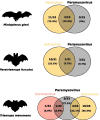Investigation of astrovirus, coronavirus and paramyxovirus co-infections in bats in the western Indian Ocean
- PMID: 34641936
- PMCID: PMC8506490
- DOI: 10.1186/s12985-021-01673-2
Investigation of astrovirus, coronavirus and paramyxovirus co-infections in bats in the western Indian Ocean
Abstract
Co-infections have a key role in virus transmission in wild reservoir hosts. We investigated the simultaneous presence of astroviruses, coronaviruses, and paramyxoviruses in bats from Madagascar, Mayotte, Mozambique, and Reunion Island. A total of 871 samples from 28 bat species representing 8 families were tested by polymerase chain reactions (PCRs) targeting the RNA-dependent RNA-polymerase genes. Overall, 2.4% of bats tested positive for the presence of at least two viruses, only on Madagascar and in Mozambique. Significant variation in the proportion of co-infections was detected among bat species, and some combinations of co-infection were more common than others. Our findings support that co-infections of the three targeted viruses occur in bats in the western Indian Ocean region, although further studies are needed to assess their epidemiological consequences.
Keywords: Madagascar; Mozambique; Multiple infections; Triaenops afer; Triaenops menamena.
© 2021. The Author(s).
Conflict of interest statement
The authors have no competing interests.
Figures





References
Publication types
MeSH terms
LinkOut - more resources
Full Text Sources

